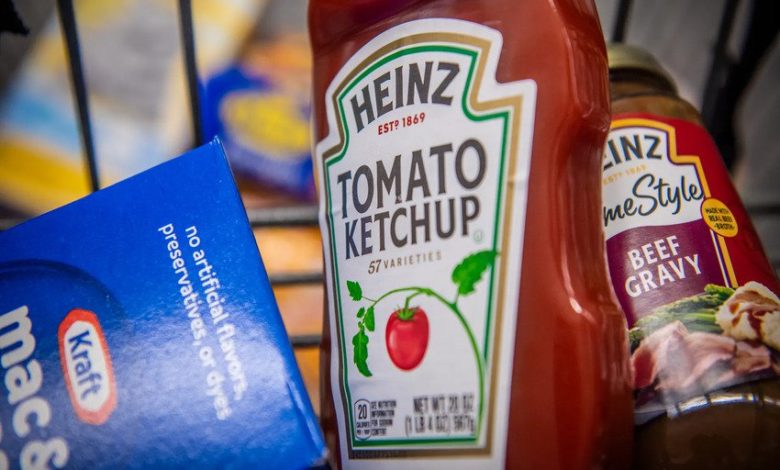Kraft Heinz Breakup Shocker: Why The $20 Billion Spin-Off Is Just The Beginning!

In a move that could reshape the packaged food landscape, Kraft Heinz (NYSE:KHC) is preparing to break itself apart—nearly a decade after the high-profile merger between Kraft and Heinz was heralded as a game-changer for the industry. As per Bloomberg reports, the company plans to spin off its slower-growth grocery business, including legacy Kraft products like macaroni and cheese, mayonnaise, and Oscar Mayer cold cuts, into a separate entity that could be valued at up to $20 billion. The remaining company would retain brands like Heinz ketchup and Grey Poupon mustard, focusing on its faster-growing sauces, dressings, and condiments segment. This dramatic restructuring follows years of underperformance, a 60% drop in stock price since the merger, and ongoing challenges in adapting to shifting consumer preferences. While management insists this isn’t a pivot from its core strategy, the breakup appears to be an urgent bid to unlock shareholder value and reposition the company for future growth.
Years Of Stagnation Following A Troubled Merger
The seeds of Kraft Heinz's breakup were sown the moment the 2015 megamerger was finalized. Spearheaded by Warren Buffett’s Berkshire Hathaway and private equity firm 3G Capital, the combination of Kraft and Heinz was expected to be a textbook case of synergy and scale. Instead, it turned into one of the most disappointing deals in recent CPG history. Early on, 3G implemented its signature zero-based budgeting, slashing costs across the board—but these savings failed to materialize into sustainable growth. By 2019, the company was forced to write down $15 billion in goodwill tied to its Kraft and Oscar Mayer brands. CEO turnover, declining sales, and operational miscues only added to the disarray. The strategy of brute-force cost reduction left Kraft Heinz ill-prepared to invest in brand modernization, innovation, and digital capabilities. In the years since the merger, the company has erased over $57 billion in market value. Despite various turnaround efforts and modest improvements, Kraft Heinz has consistently trailed behind peers in both growth and profitability. The upcoming split reflects a tacit admission that the synergies envisioned in 2015 never materialized and that the company's disparate product lines require fundamentally different strategies, investment horizons, and operating models. With the merger having failed to create a unified, high-growth entity, the breakup represents a logical—if belated—undoing of that grand consolidation.
Changing Consumer Preferences Left The Kraft Portfolio Behind
The most glaring disconnect between Kraft Heinz and the modern food landscape lies in the steady erosion of consumer demand for processed, shelf-stable, and heavily branded grocery products. While once iconic, legacy Kraft items like boxed macaroni and cheese, processed cheese slices, and canned products have fallen out of favor with consumers who increasingly value freshness, health claims, and ingredient transparency. This shift has been accelerated by generational turnover and the rapid rise of specialty, organic, and plant-based brands that cater to modern health and wellness priorities. Though Kraft Heinz has made some efforts to renovate products—such as removing artificial dyes from its U.S. portfolio and improving the nutritional profile of Lunchables—the company has often lagged behind the curve. In stark contrast, its faster-growing condiments and sauces portfolio, including Heinz ketchup, Grey Poupon, and international brands like ABC and Quero, has been better positioned to benefit from current consumer trends. These products tend to be used in home cooking, where flavor and variety are prioritized, and face less intense scrutiny over processing levels. CEO Carlos Abrams-Rivera has repeatedly stressed the company's commitment to upgrading quality through the Brand Growth System, a data-driven framework to renovate brands. But even with these efforts, the Kraft grocery segment has remained a laggard. The split is, in part, an acknowledgment that one part of the business is better aligned with where consumer demand is heading, while the other is stuck in the past and needs a different strategic lens.
Relentless Margin Pressure From Inflation, Tariffs & Promotions
The decision to break up Kraft Heinz also comes amid mounting operational and margin pressures that have disproportionately affected its grocery business. Over the past year, the company has faced elevated commodity costs in categories like dairy and coffee, the impact of inflation on packaging and distribution, and newly implemented tariffs—particularly from China—that could add 150 to 200 basis points of cost inflation in 2025. At the same time, consumer sensitivity to pricing has increased dramatically. Kraft Heinz has responded by stepping up promotional activity around key holidays and introducing value-based formats like a family-sized pack of Mac & Cheese for $2. However, these moves have weighed on gross margin. CFO Andre Maciel acknowledged that operating income will likely decline double digits in Q2 as the company ramps up marketing and sampling investments tied to product renovation efforts. And while Kraft Heinz has doubled its ROI-positive promotions over the past five years and invested in AI-driven forecasting, the sheer scale and complexity of operating both fast-growth and stagnant brands under one roof have created friction. The core grocery portfolio has become a drag on margin recovery and scalability, especially when paired with the relatively stronger economics of its sauces and condiments segment. Splitting the businesses allows each entity to pursue its own cost structure, marketing approach, and sourcing strategy without being weighed down by competing internal priorities or diluted capital allocation.
Strategic Housecleaning Already Underway Signals A Deeper Shift
Kraft Heinz's breakup is not an isolated event but the culmination of several strategic steps that have already set the stage for a more focused portfolio. Earlier this year, the company announced the sale of its infant and specialty food business in Italy, following past divestitures of the Planters nuts and natural cheese businesses. These moves reflect a consistent pruning of non-core assets and a desire to double down on growth areas aligned with the ACCELERATE segment of its brand framework, such as sauces, snacking, and ready meals. Internally, Kraft Heinz has also been scaling its Brand Growth System across more of its portfolio, improving marketing effectiveness, renovating packaging, and enhancing product quality through analytics and agile execution pods. From a governance standpoint, 3G Capital has fully exited its stake, and Warren Buffett’s Berkshire Hathaway recently gave up its board seats—further signaling a reset in how the company thinks about long-term ownership and control. With employee engagement reportedly at all-time highs and cash generation still strong, Kraft Heinz has the operational capacity to pursue a split now. This strategic housecleaning suggests the breakup is not merely a desperate act but the continuation of a broader repositioning effort that aims to prepare each business for distinct futures—whether in public markets or as potential acquisition targets in a consolidating food industry.
Final Thoughts
Source: Yahoo Finance
As we can see in the above chart, Kraft Heinz’s stock has lost more than 20% value in the past year and more than 60% since their merger. The planned breakup reflects both the hard truths of the past decade and the evolving realities of the consumer goods landscape. On one hand, it offers a chance to unlock value, sharpen strategic focus, and better align each business with its respective market dynamics. On the other, it serves as a candid acknowledgment of missteps—from an ill-fated megamerger to delayed brand modernization. Whether this separation leads to revitalization or simply creates two challenged companies instead of one remains to be seen.




